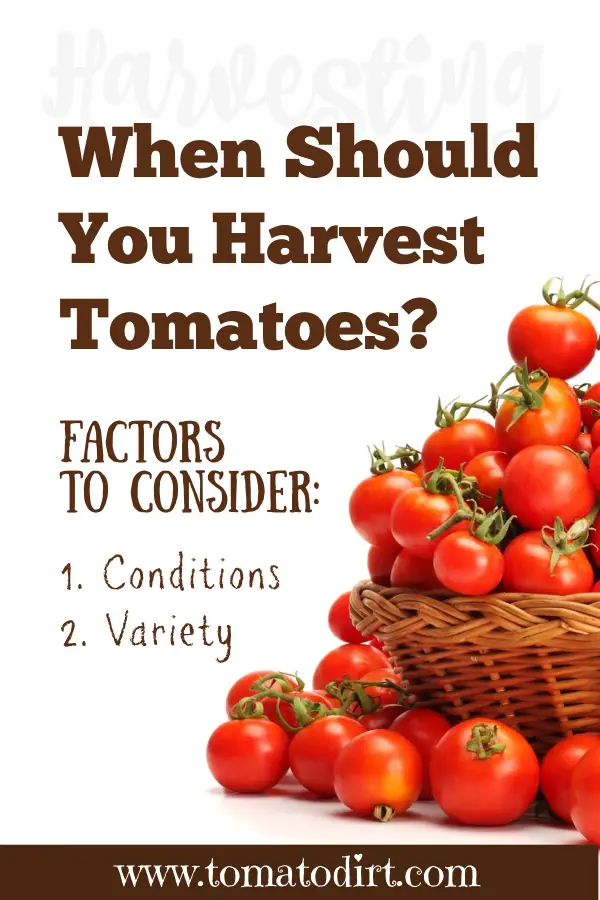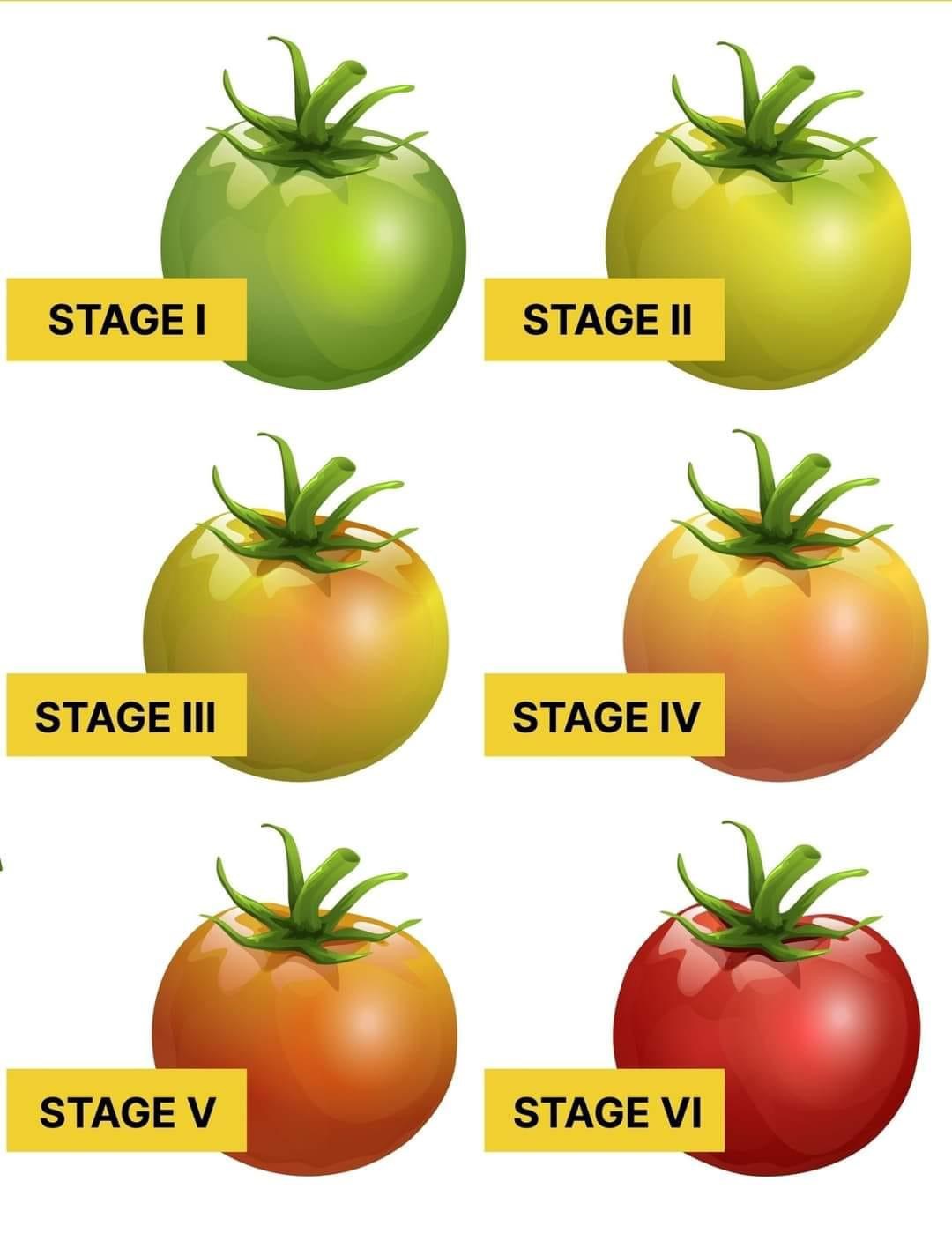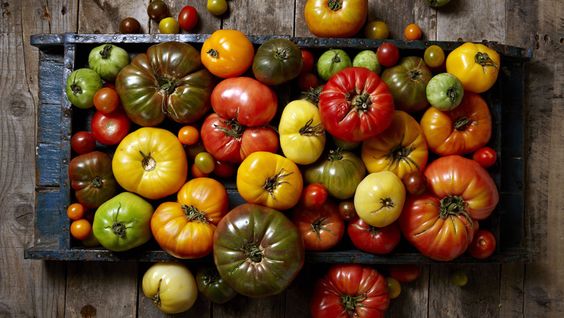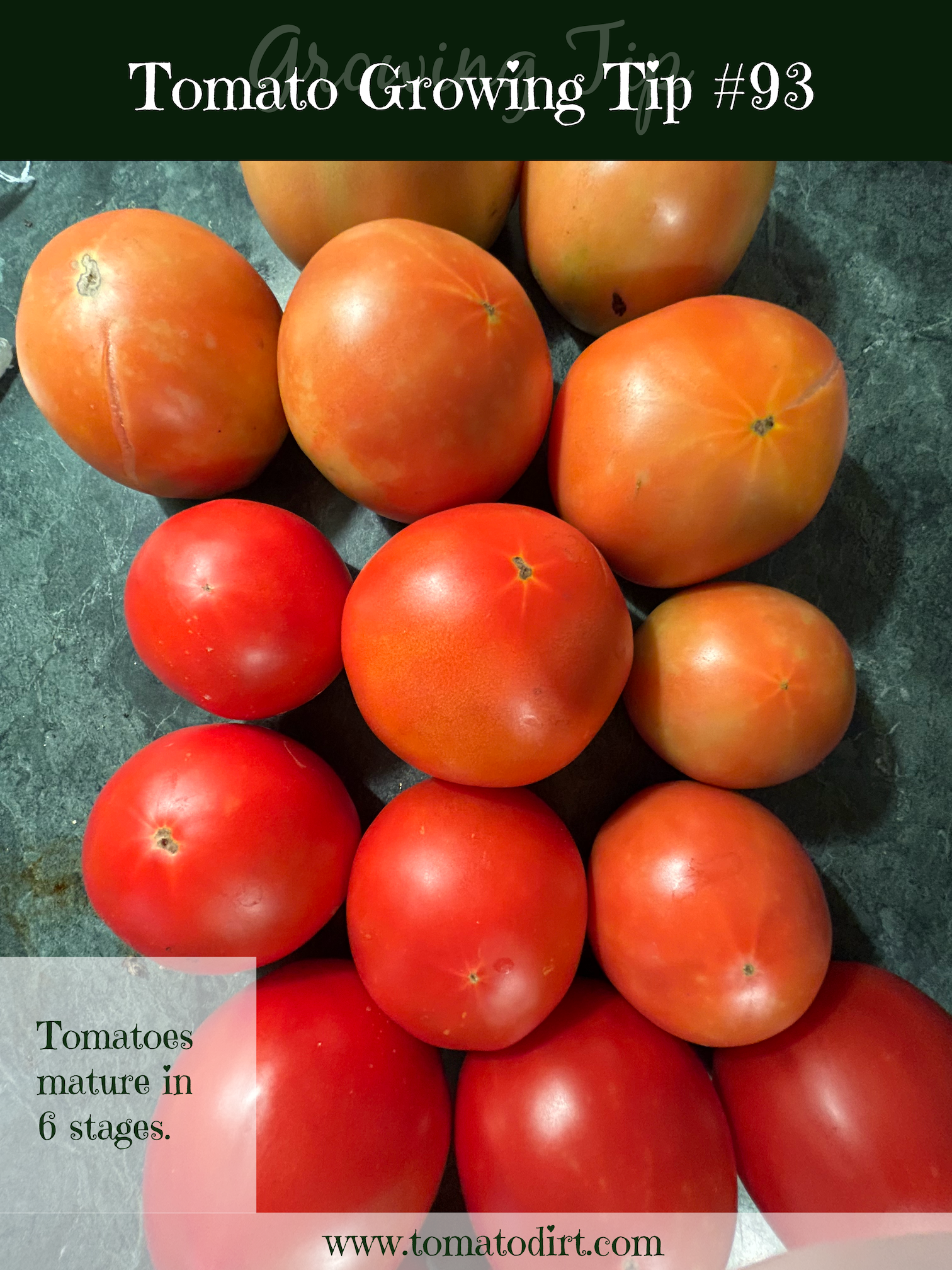Harvesting tomatoes: at last, it’s time to enjoy the fruit of your labor!
Since 2010, Tomato Dirt has garnered 4.6+ million views, making it the web’s leading online source for growing tomatoes in the home garden. Award-winning writer and Tomato Dirt owner Kathy Widenhouse has helped thousands of home gardeners grow healthier tomatoes. Be one of them when you get Tomato Dirt’s Growing Guide here.
Updated 8.16.24
Nothing tastes like a fresh tomato! Harvesting tomatoes at the right time means you get fantastic flavor. Fully ripened fruit tastes much better than fruit picked early.
That’s because once a tomato is picked, it is cut off from its main oxygen source. But even when a tomato is picked before it is ready, it continues to ripen. Its sugars are now processed without a steady supply of oxygen and are converted into compounds that promote decay – ketones, aldehydes, and alcohols. Sugar decay impacts taste. Tomatoes simply won’t taste as good as those picked in their prime.
On the other hand when tomatoes are left on the vine too long, they can bruise, rot, and decay. All that gorgeous fruit is wasted. Plus, the results are not pretty.
Top tip for harvesting tomatoes: once fruit start ripening, check plants each day and pick those that are ready. Then use these tips for harvesting tomatoes during the growing season and in the months that follow until winter knocks at your door.
First order of business: when should you begin picking tomatoes?
When is harvest time for tomatoes?
You’ll start picking 50-100 days after planting tomato seedlings in the garden. Harvesting tomatoes continues until frost (if you have some indeterminates in your crop). The time it takes for tomatoes to ripen can vary depending on several factors including the variety of tomato, weather conditions, and your gardening practices.
Factors that determine harvest time for tomatoes
Conditions
- Temperature: Tomatoes ripen best in warm temperatures (typically 70-85°F or 21-29°C). Cooler temperatures slow down ripening, while excessive heat can affect fruit quality.
- Sunlight: Tomatoes need full sun (6-8 hours daily) for optimal growth and ripening. Insufficient sunlight can delay ripening. Plus, longer daylight hours in the summer can promote faster growth and ripening.
- Soil: Well-drained, fertile soil with adequate moisture supports healthy tomato plants and promotes fruit development. Tomatoes in sandy soil have difficulty absorbing water. Tomatoes in clay soil can get waterlogged.
- Frost risk: In cooler climates, knowing the average first frost date helps determine when to harvest mature green tomatoes to avoid frost damage.
And as a gardener, you also contribute to the rate at which tomatoes ripen. When you water consistently and keep nutrient levels steady in the soil, you can promote healthy plants and quicker harvest.
Tomato variety
- Determinate tomatoes set and ripen their fruit all at one time, usually within two weeks. Be ready for a large harvest – it’s a good time for canning tomatoes, freezing tomatoes, making homemade tomato sauce, or canning tomato juice.
- Indeterminate varieties ripen all season long. You can help them to set fruit earlier by pinching off the tips of the main stems in early summer.
Then there are days to maturity, which is different for each tomato variety. Check seed packets or plant labels for days to maturity. Note that this figure is an average. Actual ripening times can vary.
- Early season tomatoes typically ripen faster, generally within 50 to 60 days from transplanting. This means you can expect ripe fruit in approximately 60 to 70 days from planting seeds indoors or transplanting seedlings outdoors.
- Mid-season tomatoes take a bit longer to ripen compared to early season varieties. They usually ripen within 70 to 80 days from transplanting.
- Late season tomatoes take the longest time to ripen. They typically require 80 to 100 days from transplanting to produce ripe fruit.
When are tomatoes ready to pick?
Tomatoes ripen in six stages.
- Green Stage (Immature Green): At this stage, the tomato is fully grown but still hard and green. It has not yet started to ripen.
- Breaker Stage: The tomato starts to show the first signs of ripening. This is characterized by a slight change in color, usually to a lighter shade of green or yellow, and the tomato begins to soften.
- Turning Stage: The tomato continues to change color from green to its mature color, which could be red, pink, orange, yellow, etc., depending on the variety. It becomes noticeably softer than in the breaker stage.
- Pink Stage: The tomato develops a pinkish hue and becomes firmer than in the turning stage. This stage is more common in some varieties.
- Light Red Stage: The tomato turns a lighter shade of red and continues to soften. It is nearing full ripeness.
- Red Ripe Stage: The tomato is fully ripened and reaches its mature color (typically red for most varieties). It is soft and juicy, ready to be picked and consumed.
These stages may vary slightly depending on the variety of tomato and environmental conditions such as temperature and humidity.
In practical terms, you know a tomato is ripe when you check –
- Color. Most tomatoes change color as they ripen, from green to yellow, pink, orange, red, or even purple, depending on the variety. The final color depends on the cultivar you're growing.
- Surface: Look for even coloring. In other words, ripe red tomatoes don’t have one side that’s green and another that’s deep red, but the entire globe has a consistent hue. The surface is glossy.
- Texture: Ripe tomatoes feel firm but give slightly when gently squeezed, without being mushy. Some gardeners say, “A tomato is ripe when it’s in between firm and soft.”
How do you pick a tomato?
- Grasp a ripened tomato gently and firmly. Twist it until it snaps off the vine.
- You can also use a clippers or knife to harvest tomatoes. Cut the stem close to the fruit.
- Be gentle to avoid bruising or damaging the fruit, which can lead to spoilage.
Harvesting tomatoes early
Let’s say it’s midsummer but you’ve got a nasty weather forecast … hail, tornadoes, heavy rain. You’ve got plenty of tomatoes on the vine, but they’re not quite ripe. You can harvest tomatoes early and still enjoy your crop. Just ensure they ripen fully indoors.
- Look for mature green tomatoes. They have grown to full size and are mature enough to ripen off the vine.
- Check for breaker stage tomatoes. If you see tomatoes that are just starting to change color from green to a lighter shade (breaker stage), these can also be harvested early. They will continue to ripen indoors.
- Provide warmth. To encourage ripening indoors, store harvested tomatoes in a warm (but not hot) location. Room temperature (around 68-77°F or 20-25°C) is ideal for ripening tomatoes. Some gardeners use ethylene-producing fruits like bananas or apples placed near the tomatoes to speed up ripening. This can help if you need tomatoes to ripen quickly.
- Monitor ripening. Check the tomatoes regularly for ripeness. They should gradually change color and become soft to the touch as they ripen.
- Store properly. Once tomatoes are fully ripe, they can be stored in a cooler place (around 55-60°F or 13-15°C) to prolong their shelf life.
Harvesting tomatoes in the fall
Your growing season is winding down. But your tomato plants continue to produce, and temperatures have not grown too cold just yet. Can you continue to pick tomatoes?
Yes! Harvesting tomatoes in the fall requires a little extra attention to timing, technique, and care to ensure the best quality fruit – but even so, you can enjoy fresh tomatoes as long as possible. Here’s the dirt.
- Time your harvest. Tomatoes should be harvested when they are fully ripe on the vine. In fall, this means monitoring the weather closely as temperatures drop, which can affect ripening.
- Check ripeness. Look for tomatoes that have reached their mature color—whether red, yellow, orange, or other hues depending on the variety. They should also feel firm yet give slightly to gentle pressure.
- Avoid frost. Frost can damage tomatoes, so if temperatures are expected to drop near freezing, get yourself out to your garden. Pick all the tomatoes on the vines even if they're not fully ripe. Allow them to ripen indoors.
- Inspect plants. Check for any signs of pests or diseases before harvesting. Discard any fruit that appears diseased or damaged.
- Harvest cleanly. Use sharp garden shears or scissors to cut the tomato from the vine, leaving a short stem attached. Handle tomatoes careful to avoid puncturing the skins or bruising the fruit. Place harvested tomatoes in a single layer in shallow container (like a garden hod) or baskets to prevent them from crushing each other.
- Store harvested fruit. Your ideal scenario? Freshly picked tomatoes ripen on kitchen counters at room temperature (around 65-75°F or 18-24°C) until you’re ready to use them. If they’re ready to use before you’re ready to eat them, then store tomatoes in a cooler location such as the garage or basement (around 55°F or 13°C) to extend their shelf life. Avoid storing them in the refrigerator unless they are overripe.
Harvesting tomatoes before frost
Cold temperatures can destroy your crop. In fact, you can keep harvesting indeterminate tomatoes until you have a killing frost. When summer temperatures begin to cool, you can extend your tomato harvest by following three simple tips:
Keep an eye on the weather forecast. If overnight temperatures dip below 40°F – or if frost is predicted – then it’s time to take action.
Harvest mature and semi-mature tomatoes – those that are red or turning yellow.
Cover remaining plants with frost protection so you can extend your harvest a few more days or weeks.
Harvesting tomatoes late in the season
As daylight diminishes, tomatoes may take longer to ripen. Use row covers or cloches to protect plants at night and when an early frost is in the forecast.
You can also tricking the plant into thinking it’s time to finish up ripening. Insert a long kitchen knife, pitchfork, or a spade a few inches from the base of the plant, penetrating the soil 8-10 inches. Make your cut just halfway around the plant. Grasp the base of the plant. Then tug gently, just enough to shift the roots ever so slightly. Also known as “root pruning,” the process interrupts your plant’s growth and stresses it enough to force it to mature more quickly than it would otherwise.
Harvesting green tomatoes
If frost threatens and you have green tomatoes left on the vine, you can harvest them and ripen them indoors. They can ripen indoors if kept in a warm, dry place with good air circulation. Check them regularly.
Or you can harvest an entire branch from your tomato plant. Leave green tomatoes on the stem, tie string or twine around the branch base, and hang it upside down in a cool location (such as the garage or basement).
By paying attention to these aspects of harvesting, you can enjoy the best flavors and quality from your fall tomato crop.
Harvesting tomato seeds
When you save tomato seeds from this year, you can have a jumpstart on next year’s crop. Plus you save money!
To harvest tomato seeds, select fully ripe tomatoes – preferably heirloom varieties, since hybrid varieties won’t be true to how they produced this year. And chose the healthiest tomatoes possible.
Then, scoop out seeds and pulp into a container. Ferment for a few days, then rinse and dry seeds for storage. Top tip: dry seeds completely before storing them in a cool, moisture-free place.
Special tips for ripening and harvesting tomatoes
- Heirloom varieties ripen before they completely turn color. Pick heirloom tomatoes before they look totally ripe.
- Cherry tomatoes crack if left on the vine too long. Pick them just before they look like they’re perfectly ripe.
- Looks count! Tomatoes ripen from the inside out. If a tomato looks ripe on the outside, it will be ripe on the inside.
- Tomatoes need warmth to ripen, not light. Fruit will continue to ripen during overcast or cloudy days that are warm or tropical.
- Tomatoes stop ripening when temperatures are above 86º F. If you have a long string of hot days, or if you live in an area that has consistently hot summers, then tomatoes may ripen to a yellow/orange color and stop. Harvest them before they turn completely red.
What to do
after harvesting tomatoes
Overripe tomatoes will fall or be knocked off stems. They rot quickly. You can easily lose a big portion of your crop if you don’t monitor your patch and keep harvesting tomatoes until frost!
Remove any leaves or debris from harvested tomato plants to reduce the risk of disease.
Consider pruning back remaining tomato plants if frost has damaged them to encourage new growth in the next season.
Harvesting tomatoes: enjoy the fruit of your labor!
It’s a special joy to pluck that first cherry tomato from the plant. And that thrill continues all through the growing season until you save that very last green tomato just before frost threatens. Enjoy every bit of your well-earned harvest.
And don’t despair when the season is over. Spring is just around the corner … and with it, a new crop of tomatoes.
More on ripening and harvesting tomatoes
When are my tomatoes ready to pick?
How To Make Tomato Plants Grow Faster ...
Is it ripe? When to pick tomatoes at peak ripeness ...
10 tips for ripening tomatoes on the vine ...
Green Tomatoes: A Gardener’s Q & A ...
Ripening green tomatoes extend your harvest ...
How Do You Ripen Tomatoes on the Vine Faster?
Should You Refrigerate Tomatoes … and If So, When?
What To Do with Green Tomatoes at the End of the Season ...
How to control fruit flies that attack your harvested tomatoes...
Tomato recipes: how to prepare fresh tomatoes to use in cooking ...
How to extend harvest of homegrown tomatoes...
Use This 6-Step Checklist for Tomato Plant Care ...
How to save tomato seeds to use next year ...
How to Take End of Season Notes about Your Tomato Garden ...
Protecting tomatoes from frost and freezing ...
Fall tomato garden clean up ...
Get more tips on our Harvesting Tomatoes Pinterest board...
Return from Harvesting Tomatoes to Tomato Dirt home
As an Amazon Associate and Rakuten Advertising affiliate I earn from qualifying purchases.
SHARE THIS PAGE:
FREE! 10 Must-Know Tomato Growing Tips: 20-page guide
Get yours here:








New! Comments
Have your say about what you just read! Leave a comment in the box below.